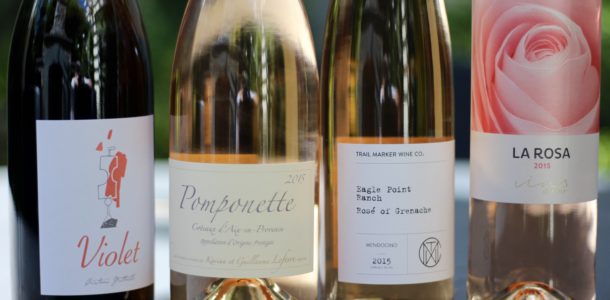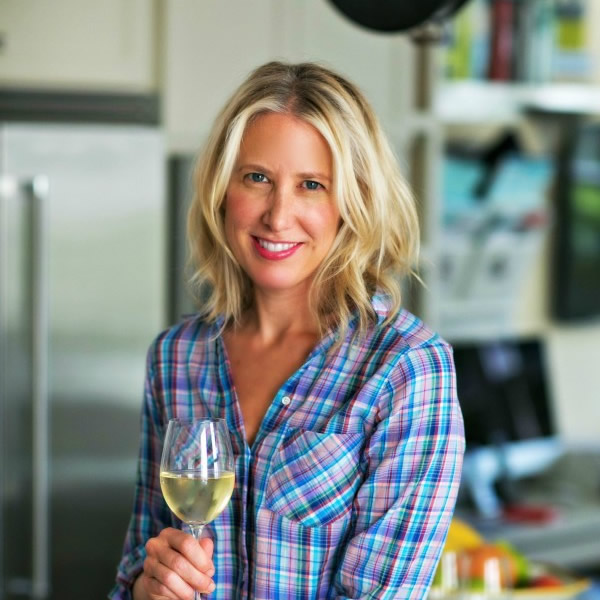Those lovely, inexpensive summer rosés that go down like water? Most are industrial products, with conventional farming, high sulfur levels and who knows what else. Not these. Super clean, from smaller, family-owned estates or even smaller mom & pop shops. They’re all practicing (or certified) organic, with a few taking it one step further to biodynamics, fermenting with native yeasts only, and adding nothing but a small amount of sulfur at bottling.
2015 Trailmarker Eaglepoint Ranch Rosé of Grenache; Mendocino, CA
Drew Huffine never intended to make his career in wine, but after getting the bug early while in college at UCSB, he eventually succumbed. Of course, these things never truly happen in a vacuum. It took the urging of a friend to get him up north working harvests, which led to winemaking positions at several prominent wineries, including Kosta Browne. The final nudge came from his wife who convinced him they should start their own label – Trail Marker. With connections throughout California from his previous jobs, Drew was able to source high quality fruit immediately – including Eaglepoint Ranch in Mendocino. This certified organic vineyard’s 1800 foot elevation keeps the temperatures several degrees colder than the valley floor and the red loam in the soil is perfectly suited to Rhône varieties like Grenache Noir. He calls himself a “purist” which is clearly evident in this Rosé of Grenache. Strawberry and white peach notes fill out the lean core of this wine, which is unfiltered – its all about freshness, crisp acidity, grapefruit and a savory, long finish.
2015 Domaine de Sulauze ‘Pomponette’ Rosé; Provence, France
Karina and Guillaume Lefèvre took over Domaine de Sulauze in 2004, and immediately transitioned to organic farming, quickly adding in biodynamic practices as well. Today, in addition to grapes, Guillaume and Karina also grow olives, chickens and pigs, plus grains used for the breads they bake in an ancient oven, barley and hops for their brewery, and have a vast vegetable and herb garden. They truly walk the walk when it comes to living sustainably. Theirs is a studied and somewhat complex method for making rosé. The Vermentino, Grenache, Cinsault and Mourvèdre are all direct-pressed, while the Syrah juice is run off (called saignée). All the juice co-ferments, with each new day’s fruit innoculated with the ferment from the previous day’s tank. The wine is bottled in March following the vintage, without filtration and a tiny amount of SO2. While the production method might be unusual, this is classic Provençal rosé. Pale orangey-pink, notes of peach, blood orange and strawberry, with some bitter notes to offset the sweet fruit – it kind of reminds me of Aperol or Campari. Delicious and clean, for elevated, headache-free day drinking and poolside sipping. #roséallday
2013 Guttarolo Violet Rosato of Primitivo; Puglia, Italy
Far from the plains of Puglia which often produce hot, flabby wines, here vines sit on a plateau of fossilized limestone 400 meters above sea level. It is cooler than usual in the daytime thanks to a stiff wind from the sea, while the site’s elevation ensures the wide range of temperatures between day and night that allows the grapes to ripen fully while retaining freshness. The wines are clearly Pugliese, full of wild, sun-drenched fruit, but they have a balance and minerality often missing in the region’s wines. Vineyard work is excellent, organic and done entirely by hand, and Cristiano avoids the use of additives entirely. Fermentation was all done in stainless and was quick (12 hours) at a fairly high temperature with multiple pumpovers (not carbonic), giving the wine some texture and tannins from the skin. No sulfur was added. This is not your simple picnic rosé – it’s a bit of an oddity: bone-dry, a little tannic, more like a skin-contact orange wine, cerebral and extremely delicious.
2015 Raventos i Blanc Vin de Terrer ‘La Rosa’; Peñedes, Spain
The Raventós family is essentially the first family of Cava – it was an ancestor of the current owners who produced the first bottles in 1872, and the estate has been in the family since 1497. While some producers with this type of heritage are content to rest on their laurels and increase production to capitalize on the growing popularity of Cava around the world, as many other producers did, they undertook a massive project to study and identity the different soil types throughout their property. They also became certified biodynamic in the vineyards and modernized the winery. Through this process they found that their wines were not adequately protected by the D.O., (the governing body that makes the viticulture and winemaking rules for the region), so they removed themselves from it altogether. A bold move for a winery that is still family-owned. While their primary focus remains sparkling wine, they also produce a few still wines, like the La Rosa. Produced from just a few rows of Pinot Noir planted on the top of the highest hill on the property, it takes its name from the roses interplanted in the vines. And it tastes as pretty as it looks! Light and refreshing, with just the right amount of strawberry and zesty acidity, it begs to be enjoyed outside, before noon, on a sunny day.
2014 Cosimo Maria Masini ‘Matilde’ Rosato; Tuscany, Italy
Grapes have been grown on the site of the Cosimo Maria Masini estate since the 1600’s, though it was not acquired by the Masini family until 1997. In the meantime, it was held by none other than Napoleon Bonaparte and after that, the founder of the Italian Faculty of Agriculture. With such a distinguished past, it should come as no surprise that the Masinis made several exciting discoveries when they began rehabilitating the property, including a very few, old, Sanforte vines. Sanforte, unique to Tuscany, was previously thought to be Sangiovese, and produces a wine that is slightly more full bodied. The Masinis lovingly restored these vines and converted the entire property to biodynamic viticulture in 2005. The Matilde rosato, certified biodynamic and organic, is 80% Sangiovese + 20% Sanforte that is fermented in concrete and bottled unfined/unfiltered and with only a tiny amount of SO2 at bottling. More than just a summer quaffer, its savory, watermelon notes and typical Sangiovese sour cherry complement delicate rose petal aromas. This one goes both ways – an excellent food wine, and delicious on its own.
2015 Stolpman Rosé; Santa Barbara County, CA
Peter and Jessica Stolpman practice not only clean farming and winemaking, but also employ what might be the most progressive fair trade policies in the US wine business. Their vineyard team is employed year round (instead of seasonally, as with most wine operations), earn true living wages and a share of the profits. The vineyards have been organic and dry farmed since day one, so the soils have never seen pesticides. Here, for their beautiful light pink rosé, 100% Grenache, grapes are harvested early to avoid over-sweetness and high alcohol. 30% of the grapes are left as whole clusters (with stems) and allowed to ferment, uncrushed, in a carbonic environment. This adds a whole layer of complexity, giving the wine texture, body and amazing freshness. It’s bright, juicy, with watermelon and strawberry notes, but also a vein of savory herb and acid. So refreshing, and drinkable – especially at 11% alcohol.







No comments yet.